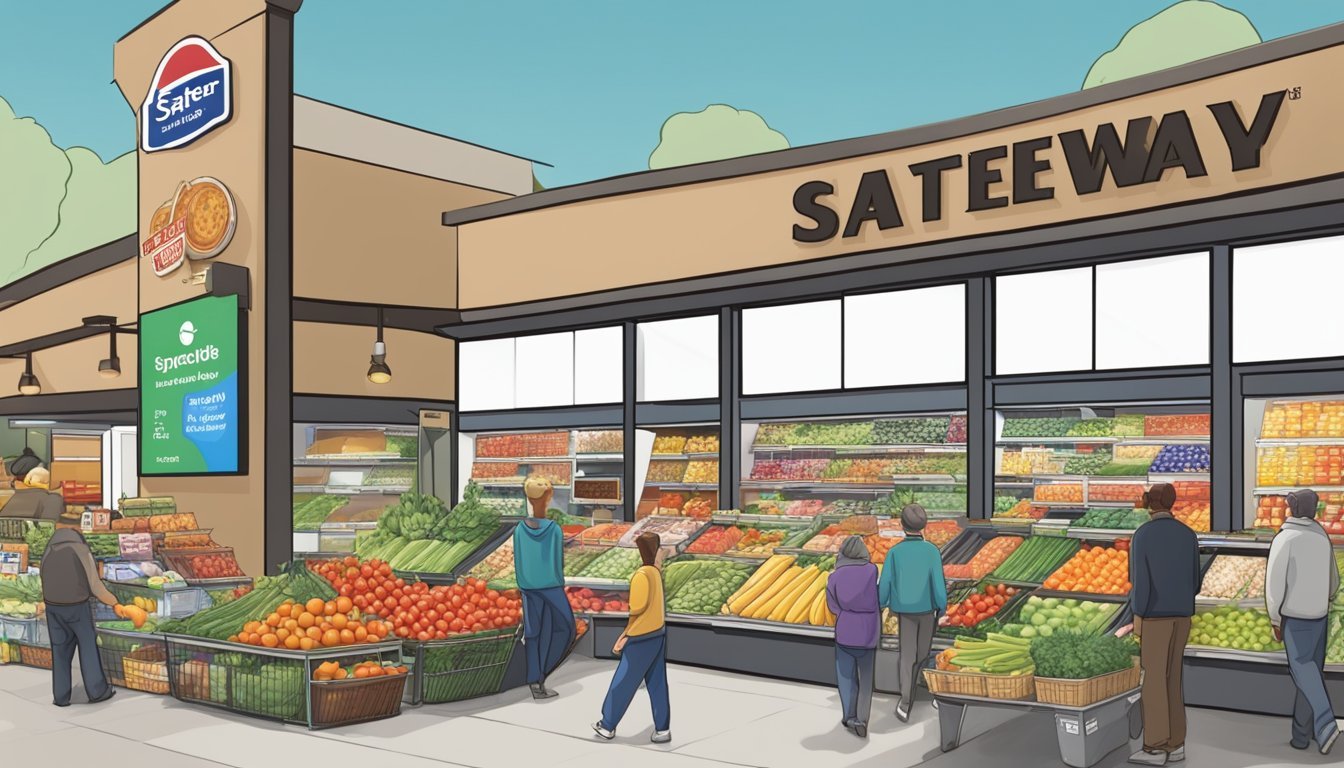Safeway vs Stater Bros. Markets
A Comprehensive Comparison of Prices, Quality, and Service
Grocery shopping is a weekly ritual for many Americans, with store choice often coming down to price, quality, and convenience. Two popular chains, Safeway and Stater Bros. Markets, each have their loyal customer bases in different regions of the country.
Safeway, a nationwide chain, offers a wide selection of products and frequent sales promotions. Stater Bros. Markets, primarily located in Southern California, is known for its competitive prices and quality meat department. While Safeway provides a more extensive nationwide presence, Stater Bros. Markets edges ahead in meat quality and customer service.
Both stores aim to meet the diverse needs of shoppers, from budget-conscious families to those seeking premium products. The choice between Safeway and Stater Bros. Markets often depends on individual preferences and local availability.
Comparison of Safeway and Stater Bros Markets
Safeway and Stater Bros Markets are prominent grocery chains with distinct histories and market positions. Both offer a range of products and services to meet consumer needs, but differ in their geographic focus and store formats.
Brand History and Market Presence
Safeway traces its roots back to 1915 and has grown into a major national chain. It operates over 900 stores across the United States and is part of Albertsons Companies. Safeway has a strong presence in the western and central U.S.
Stater Bros Markets, founded in 1936, remains a regional supermarket chain. It focuses exclusively on Southern California, with around 170 stores. Stater Bros has built a loyal customer base in its home region.
Safeway's larger scale allows for more diverse store formats and product offerings. Stater Bros emphasizes a neighborhood grocery store feel with a reputation for quality meats and produce.
Store Locations and Convenience
Safeway's nationwide presence provides greater convenience for shoppers who travel frequently. Its stores can be found in urban centers, suburbs, and some rural areas across multiple states.
Stater Bros concentrates its locations within Southern California. This focused approach allows for efficient distribution and a deep understanding of local preferences. Shoppers in this region often have a Stater Bros nearby.
Both chains face competition from Walmart, Target, and other supermarkets. Safeway tends to have larger store footprints, while Stater Bros typically maintains medium-sized locations. Each aims to balance product variety with shopper convenience.
Product Range and Quality
Safeway and Stater Bros. Markets offer diverse product selections to meet customer needs. Their offerings span fresh produce, meats, organic items, and prepared foods, with some key differences in quality and variety.
Fresh Produce Comparison
Safeway provides a wide array of fruits and vegetables, including seasonal and exotic options. Their produce section often features locally sourced items and a dedicated organic area. Stater Bros. Markets, while offering a solid selection of fresh produce, may have a more limited variety compared to Safeway. Both chains prioritize freshness, but Safeway's larger stores sometimes allow for more extensive produce displays.
Safeway typically offers more pre-cut fruit options and bagged salads for convenience. Stater Bros. Markets tends to focus on staple produce items at competitive prices. Quality can vary by location and season for both chains.
Meat Department Analysis
Stater Bros. Markets has built a strong reputation for its meat department. The chain is known for high-quality meats and skilled butchers who provide custom cuts. Their selection includes fresh beef, pork, poultry, and sometimes specialty meats like lamb.
Safeway's meat department offers a broad range of options, including organic and grass-fed choices. They carry standard cuts as well as marinated and seasoned meats for quick meal preparation. Both stores provide USDA graded beef, but Stater Bros. often receives praise for its meat quality and customer service in this department.
Availability of Organic and Whole Foods
Safeway has expanded its organic offerings in recent years, featuring its O Organics line across multiple departments. They stock a variety of organic produce, dairy, meats, and pantry items. Whole grain products and alternative flours are readily available.
Stater Bros. Markets has a more limited organic selection compared to Safeway. They do offer some organic produce and packaged goods, but the range is not as extensive. Both stores carry natural and health-focused brands, with Safeway generally providing more options in this category.
Prepared Foods and Deli Selections
Safeway excels in prepared foods, offering a wide range of ready-to-eat meals, salad bars, and hot food stations in many locations. Their delis feature made-to-order sandwiches, rotisserie chickens, and a variety of pre-made salads and side dishes.
Stater Bros. Markets' prepared foods section is typically smaller but still provides essentials like rotisserie chickens and basic deli offerings. Their focus is more on traditional deli meats and cheeses rather than elaborate prepared meals.
Both chains offer catering services, but Safeway usually provides a broader menu with more gourmet options. Stater Bros. Markets' prepared foods tend to be more straightforward, catering to customers looking for quick, familiar meal solutions.
Pricing and Value for Money
Safeway and Stater Bros. Markets employ distinct pricing strategies and offer various ways for customers to maximize savings. Both chains aim to provide value, but their approaches differ in key areas.
Everyday Pricing Strategies
Safeway tends to have higher regular prices compared to Stater Bros. Markets. Stater Bros. focuses on maintaining consistently lower everyday prices across their stores. This approach appeals to budget-conscious shoppers who prefer straightforward pricing without the need to hunt for deals.
Safeway, on the other hand, relies more heavily on promotional pricing and temporary discounts. They often use loss leaders - items priced at or below cost - to draw customers into stores. This strategy can benefit savvy shoppers who plan their purchases around sales cycles.
Comparison of Sales and Discounts
Stater Bros. offers weekly specials and occasional deep discounts, but their sales are generally less frequent and less dramatic than Safeway's. Their focus is on steady, competitive pricing rather than fluctuating deals.
Safeway runs more frequent and varied promotions. These include:
Buy One Get One Free offers
Mix and match deals (e.g., 10 for $10)
Personalized deals through their app
Safeway's approach can lead to significant savings for customers who actively engage with their promotions. However, it also requires more effort to track and capitalize on these changing offers.
Loyalty Programs and Member Benefits
Safeway's Just for U program is more robust than Stater Bros.' loyalty offerings. Just for U features:
Personalized digital coupons
Gas rewards
Special member-only pricing
Members can stack these benefits for additional savings. The program integrates with Safeway's app, making it easy for tech-savvy shoppers to access deals.
Stater Bros. has a simpler loyalty program focused on digital coupons and occasional member-only specials. While less comprehensive, it aligns with their straightforward pricing philosophy.
Both stores offer online ordering and delivery services, but pricing and availability vary by location.
Consumer Experience and Service
Safeway and Stater Bros. Markets prioritize customer satisfaction through their service offerings and store environments. Both chains strive to create positive shopping experiences, though they differ in some aspects of their approach.
Customer Service and Support
Safeway provides a range of customer support options, including in-store assistance and online channels. Their staff members are generally knowledgeable about product locations and can offer recommendations. Safeway's loyalty program offers personalized deals and discounts to frequent shoppers.
Stater Bros. Markets is known for its friendly, attentive service. The chain emphasizes employee training to ensure staff can assist customers effectively. Stater Bros. often receives praise for its meat department service, with butchers available to provide custom cuts and advice.
Both stores offer refund and exchange policies for customer satisfaction. Safeway tends to have more self-checkout options, which some customers find convenient, while Stater Bros. focuses on personalized service at traditional checkouts.
Store Cleanliness and Shopping Environment
Safeway stores typically feature wide aisles and clear signage, making navigation easier for shoppers. The chain invests in regular store updates to maintain a modern appearance. Produce sections are usually well-organized with a focus on presentation.
Stater Bros. Markets pride themselves on cleanliness and organization. Their stores often have a more traditional supermarket feel, with an emphasis on a tidy, no-frills shopping environment. The chain regularly maintains its facilities to ensure a pleasant shopping experience.
Both retailers implement cleaning protocols to maintain hygiene standards. Safeway stores sometimes incorporate more modern design elements, while Stater Bros. focuses on a straightforward, practical layout. Customer reviews generally indicate satisfaction with the cleanliness of both chains, though individual store experiences may vary.
Brand Ethos and Social Responsibility
Safeway and Stater Bros. Markets have distinct approaches to corporate responsibility and community engagement. Their efforts in product sourcing, animal welfare, and sustainability reflect their core values and commitment to customers.
Focus on Animal Welfare and Product Sourcing
Safeway emphasizes ethical sourcing and animal welfare in its product offerings. The chain stocks organic chicken and grass-fed beef, addressing consumer demand for humanely raised meat. Safeway has committed to phasing out gestation crates for pigs and battery cages for laying hens in its supply chain.
Stater Bros. Markets also prioritizes quality and responsible sourcing. The company partners with local farmers and ranchers to provide fresh, locally-sourced products. Stater Bros. offers antibiotic-free and hormone-free meat options, catering to health-conscious consumers.
Community Involvement and Sustainability Efforts
Safeway actively supports local communities through various initiatives. The Safeway Foundation funds programs focused on hunger relief, education, and health. The chain has implemented energy-efficient technologies in its stores and distribution centers to reduce its environmental impact.
Stater Bros. Markets prides itself on its deep community roots. The company regularly donates to local food banks and sponsors youth programs. Stater Bros. has invested in recycling programs and energy-efficient equipment to minimize waste and conserve resources. The chain's "Green Waste" program diverts organic waste from landfills, supporting sustainability efforts.
Conclusion
Safeway and Stater Bros. Markets each offer unique strengths for grocery shoppers. The choice between them depends on individual preferences and priorities.
Final Verdict on Safeway vs Stater Bros Markets
Safeway excels in product variety and convenience. Its larger stores carry a wide range of brands and specialty items. The chain's loyalty program and digital coupons can lead to significant savings for regular shoppers.
Stater Bros. Markets stands out for its competitive pricing and quality meats. The company's focus on fresh produce and local sourcing appeals to health-conscious consumers. Stater Bros. also earns praise for its friendly customer service.
For budget-conscious shoppers, Stater Bros. often has lower everyday prices. However, Safeway's frequent sales and promotions can result in better deals on specific items.
Those who prioritize organic and natural options may prefer Safeway's broader selection in these categories. Stater Bros. offers a more limited but growing range of organic products.
The best choice ultimately depends on location, shopping habits, and personal preferences. Both supermarkets provide solid options for groceries and household essentials.








